|
Click images
for full-size version |
|
|
|
|
|
General Tumamoc globeberry |
|
|
|
|
| |
|
|
|
|
|
| |
 |
|
_sm.jpg) |
|
_sm.jpg) |
| |
Tuma leaves,
stems, and tendril.
Sabino Canyon, Aug. 2, 2008 |
|
Tuma in
buckhorn cholla (Opuntia acanthocarpa). Numerous red and green
fruits dangle from the vine.
Anklam Road, Aug. 25, 2012
|
|
Tuma in Blue
paloverde (Cercidium floridum). One green (not yet mature) fruit is in
the center.
Sabino Canyon, Aug. 31, 2009 |
| |
|
| |
Seedlings & Juveniles |
|
|
|
|
| |
 |
|
_sm.jpg) |
|
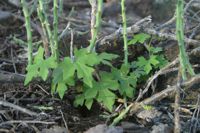 |
| |
Seedling Tuma among fallen twigs and branches
primarily Foothills paloverde (Cercidium microphyllum).
Tumamoc Hill, Aug. 11, 2007 |
|
Juvenile Tuma among rocks.
Tumamoc Hill, Aug. 11, 2007 |
|
A cluster of 5
seedling Tumas. All five undoubtedly arose from seeds of the same fruit.
Among stems of
Christmas cactus (Opuntia leptocaulis). None survived to the
2009 survey.
Tumamoc Hill, Aug. 11, 2007 |
| |
_sm.jpg) |
|
_sm.jpg) |
|
 |
| |
Juvenile Tuma among rocks. The plant is rooted
in the crevice in the far upper left.
Tumamoc Hill, Aug. 11, 2007 |
|
Juvenile Tuma among rocks.
Tumamoc Hill, Aug. 11, 2007 |
|
Seedling Tuma. One of the cotyledon leaves is
just visible in the lower left of the plant.
Tumamoc Hill, Aug. 29, 2009 |
| |
 |
|
|
|
|
| |
Tuma seedlings
a few days old. Cotyledon leaves will wither and fall off in another
few days. Metallic object in foreground is a numbered galvanized steel
nail marker.
Picture Rocks Road, Aug. 1986 |
|
|
|
|
| |
|
| |
Adults |
|
|
|
|
| |
_sm.jpg) |
|
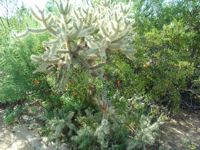 |
|
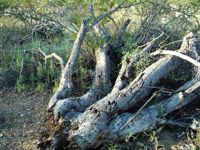 |
|
Large adult
Tuma left & right of trunks of Foothills paloverde (Cercidium microphyllum), reaching to the top of
the frame. Pin flags mark the locations of several juvenile progeny of
the adults.
Picture Rocks Road, Sept. 1, 2007 |
|
Large adult
Tuma in Jumping cholla (Opuntia fulgida); creosotebush (L. divaricata) behind with numerous dangling green
and red fruits. Pin flags mark the locations of several seedlings and
juveniles.
Picture Rocks Road, Sept. 1, 2007 |
|
Adult Tuma
clambering on dead Foothills paloverde (Cercidium microphyllum). It is likely that the tree was alive
when the Tuma germinated and established.
Saguaro National Park West, Sept. 1, 2007 |
| |
 |
|
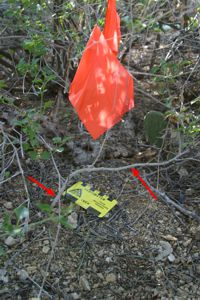 |
|
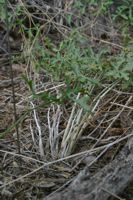 |
| |
Large adult Tuma stem
indicated by red arrows. The largest stems approach 1 cm diameter at the
base and may survive the winter. Smaller stems completely wither away to
the ground.
Both images from Sabino Canyon. Left: Aug. 21, 2011. Right: Aug. 31,
2009 |
|
Large adult Tuma with multiple stems arising
from a cluster of tubers.
Sabino Canyon, Aug. 21, 2011 |
| |
|
| |
Flowers & Fruits |
|
|
|
|
| |
_sm.jpg) |
|
_sm.jpg) |
|
_sm.jpg) |
| |
Large adult
Tuma with open flowers and immature fruits. The open flowers all appear
to be male.
Sabino Canyon, Aug. 21, 2011 |
|
Adult Tuma on buckhorn
cholla (Opuntia acanthocarpa) with numerous mature (red) and
maturing (orange) fruits.
Anklam Road, Aug. 25, 2012 |
| |
_sm.jpg) |
|
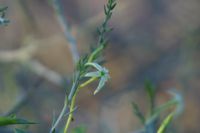 |
|
_sm.jpg) |
| |
Female flower
showing the slightly swollen inferior ovary. Female flowers are
solitary, produced on short pedicels (stalks) in leaf axils as are the
grasping tendrils.
Tumamoc Hill, Aug. 8, 2012 |
|
Male flower
raceme with one open flower near the apex. Note the apical stems of
Range ratany (Krameria sp.) in front of and behind the Tuma
flower raceme.
Tumamoc Hill, Aug. 25, 2012 |
|
Male flower
just opening early in the morning and a tendril.
Tumamoc Hill, Aug. 11, 2007 |
| |
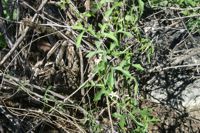 |
|
 |
|
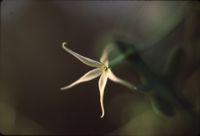 |
| |
Adult Tuma
with mostly open male flowers and one green fruit.
Sabino Canyon, Aug. 29, 2008 |
|
Male Tuma
flowers.
Picture Rocks Road, Aug. 1986 |
|
Female Tuma
flower.
Picture Rocks Road, Aug. 1986 |
| |
|
| |
Drought Stress |
|
|
|
|
| |
 |
|
_sm.jpg) |
|
 |
| |
Drought
stressed Tuma leaves and a male flower raceme. Adult plants begin
developing flower racemes and buds in the weeks prior to monsoon onset.
Most are aborted. This is shown near the end of a meager monsoon.
Sabino Canyon, Aug. 31, 2009. |
|
Drought
stressed Tuma leaves and male flower racemes. Although the male flower
racemes continue to produce buds, nearly all are aborted. Even plant
tendrils shown here are dessicated. Heavy rains, well into September can
produce episodes of flower and fruit development.
Sabino Canyon, Aug. 31, 2009. |
|
Drought-stressed adult Tuma. The finger is highlighting a tiny female
flower bud. Male racemes frame the finger, each showing several aborted
male flower buds.
Tumamoc Hill, Aug. 20, 2011. |
| |
_sm.jpg) |
|
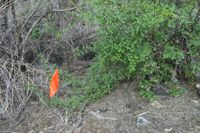 |
|
_sm.jpg) |
| |
Plant A2, a very large
adult Tuma. Pin flag marks emergence of multiple semi-woody stems. The
plant was highly drought-stressed in 2009. Several stems were aborted,
although a single yellow fruit is visible near top center. In 2011 the
plant is vigorously producing flowers and fruits.
Both images from Sabino Canyon. Left: Aug. 31, 2009. Right: Aug. 21,
2011 |
|
Aborted adult Tuma stem in Range ratany (Krameria
sp.) with dried red fruits. Seeds in the fruits are probably viable. The
stem is dessicated either because it aborted or the stem was clipped by
a hopeful browsing animal.
Tumamoc Hill, Aug. 29, 2009 |
| |
|
|
|
|
|
| |
|
|
|
|
|

_sm.jpg)
_sm.jpg)

_sm.jpg)

_sm.jpg)
_sm.jpg)


_sm.jpg)





_sm.jpg)
_sm.jpg)
_sm.jpg)
_sm.jpg)

_sm.jpg)




_sm.jpg)

_sm.jpg)

_sm.jpg)